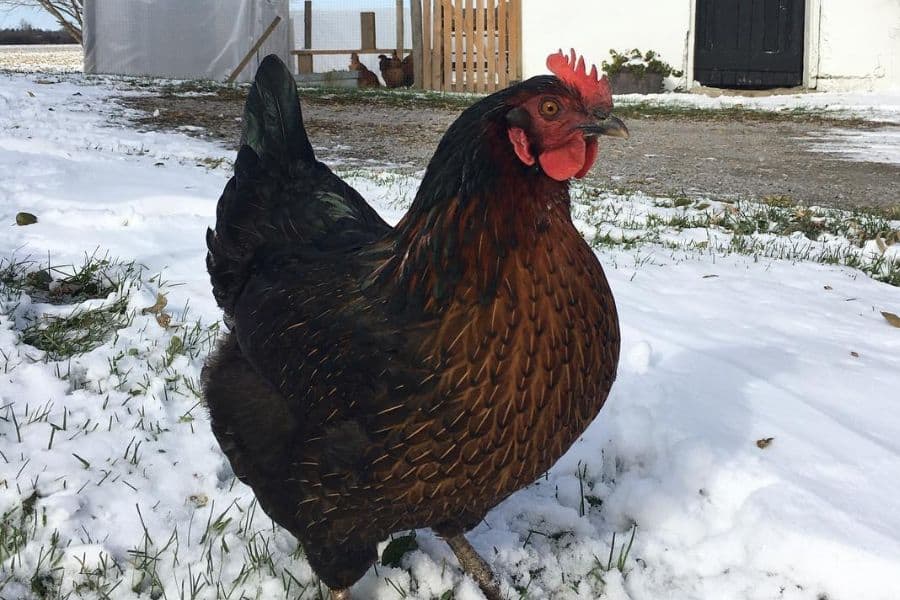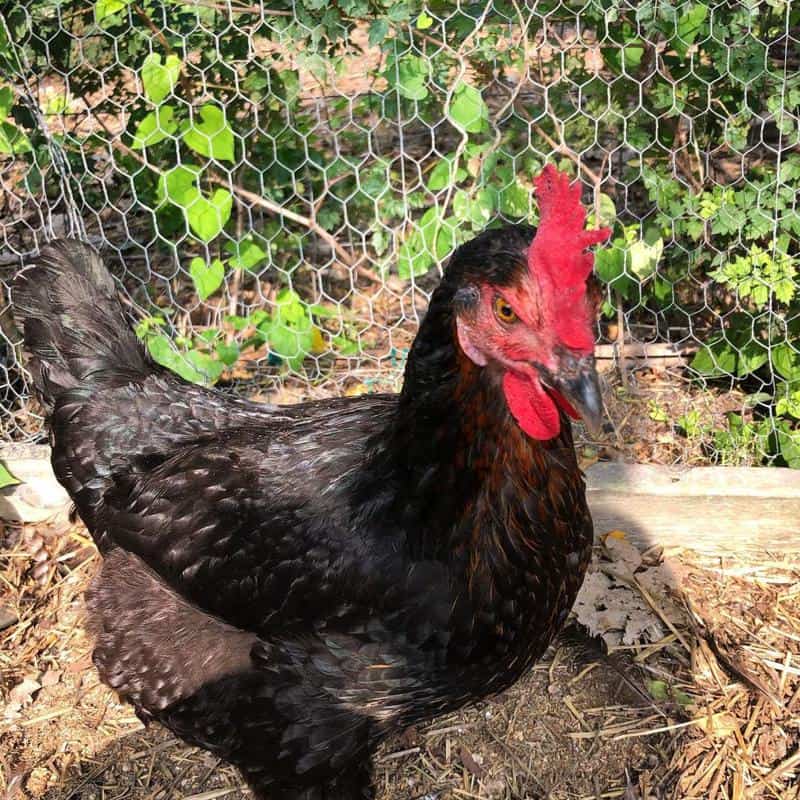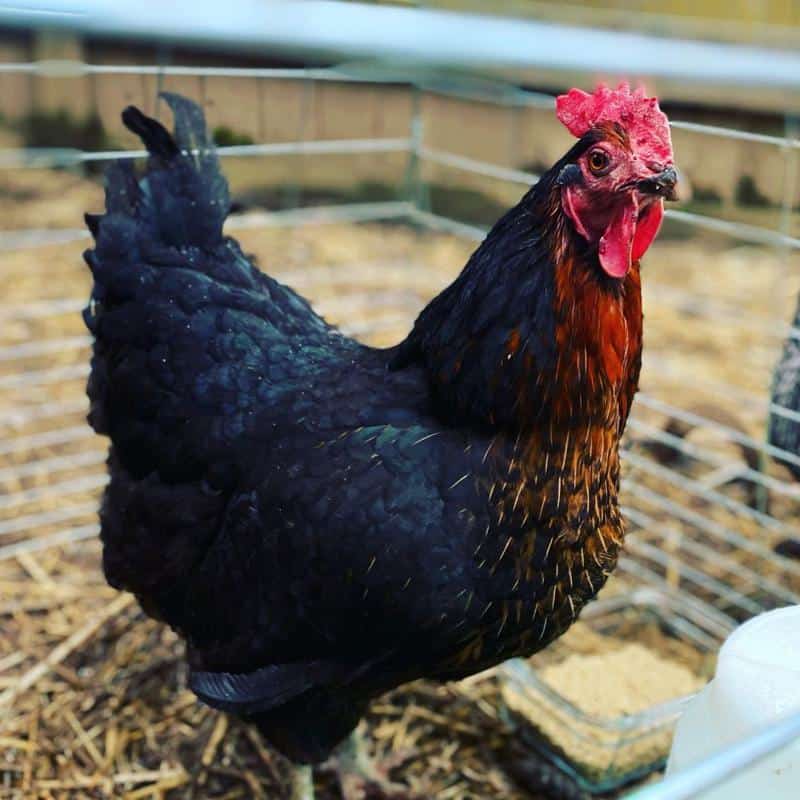As a chicken parent, knowing the ins and outs of a chicken breed before adding it to your flock is essential. That way, you can determine whether you’re bringing on board the perfect breed for your needs, and if yes, learn the best way to care for your new addition.
And with you being here, you’re likely considering making the Black Star chicken breed part of your poultry population. But is it the best breed for your home, or would it be better to steer clear of it and consider another breed instead?
Well, we’ve got all these answers — and even more — in our coverage. From their appearance and disposition to their egg-laying behavior and common health problems, we’ve captured every iota of detail you may want to know about this chicken breed and put it in today’s blog post. Read on to discover more!
Black Star Chicken Overview

The table below perfectly summarizes some of the essential details about Black Stars.
| Breed size | Medium to large |
| Weight | Roosters: Upto 8 lbs
Hens: Upto 6 lbs |
| Color of feathers | Hens: Black feathers with red to golden flaking on the chest
Roosters: Black with white feathers, similar to Barred Rocks |
| Dual-purpose | Yes |
| Disposition | Quiet and docile, adaptable, friendly, and curious |
| Number of eggs per year | 250 to 300 |
| Egg size | Large to extra large |
| Egg color | Brown |
| Skin color | Yellow |
| Leg color | Yellow |
| Number of toes per leg | 4 |
| Comb type | Single |
| Color of combs, wattles, and ear lobes | Red |
| Maturity | 20 weeks |
| Lifespan | About 5 years |
| Common health problems | Egg binding, Egg yolk peritonitis, and Cancers |
The Origin
The Black Star, also known as the Black Beauty, Black Sex Link, or Black Rock, is an English chicken breed that comes from cross-breeding a Barred Plymouth Rock hen with either a Rhode Island or a New Hampshire male.
The hybrid was invented in the mid-twentieth century, only a few years after World War II (WWII). The primary driving force for this invention was the increasing food demand after the war, so the breeders wanted a bird that would meet the high grocery needs of the expanding population.
That meant they were primarily targeting a twofer-kind-of-bird, a chicken with excellent egg-laying capabilities and, at the same time, one that would play the role of a table bird exceptionally well.
So, to try and come up with that one “super” chicken breed that would meet these needs, poultry scientists opted to cross and recross several breeds, efforts that yielded the now popular Black Star chicken breed!
Appearance

On appearance, the Black Star chicken is exactly what the name says — black! But it’s not entirely black.
In the case of the hens, the black plumage comes matched with a red to golden flaking around the breast. That’s slightly different from males. In their case, they have an appearance similar to that of the Barred Rock breed.
But then, it’s worth noting that the barred-rock-like appearance of the roosters becomes clearer as they feather out.
However, that’s not to say you can’t distinguish male and female Black Star chicks. You can, and actually, right from day one, and that’s simply because the Black Star is one of the sex-linked chicken breeds.
By “sex-linked”, we mean that you can distinguish the male and female Black Star chicks right after they are hatched by simply looking at them. Both chicks are all-black after hatching, but you can easily tell that you have a male by looking for a white spot on the head.
In other words, the Black Star isn’t one of the breeds where you will buy a male chick thinking you’re getting a female one or vice-versa. You can simply tell what exactly you’re buying, even when the chicks are a day old.
The Black Star chickens have a single comb that’s red in color, which is the same color as their wattles and ear lobes. Each of their four-toed legs is clean and yellow, which, by the way, is still the same color of their skin.
Size
About size, the Black Star isn’t one of the pint-sized chicken breeds, and neither can you group it among the poultry giants. It’s somewhere between a medium and large bird and perfectly exhibits the robust nature of the parents.
The Black Star chicken breed grows really fast and will weigh anywhere between 5 and 8 pounds when fully mature. Usually, it’s the hens that operate at the lower end of this spectrum, while the males tend to lean more toward the opposite end.
Personality and Temperament

Of course, as you factor in the size, egg-laying capabilities, and other factors, you don’t want to leave out the disposition aspect when considering whether or not the Black Star makes the ideal addition to your chicken population.
After all, you most likely don’t want a bird that won’t get along with the rest of the flock or a kind that poses a threat to the little members of the family.
And thankfully, the Black Star isn’t one of these chicken breeds.
On top of being a dual-purpose bird, this chicken has an excellent disposition and would, therefore, make a perfect addition to your poultry population. Let’s carefully examine the general temperament of the breed.
Quiet and Docile
If you live in close proximity to your neighbors, you’ll be happy to learn that the Black Star isn’t one of the chicken breeds that will ruin their peace. This breed seldom raises its voice, so it’s a good go-to if you don’t want the kind of noise that can attract a squabble between you and your neighbors.
Of course, that’s not to say they don’t make any noise. They do, just like any other bird, but there will always be a big reason for their vocality. In most cases, the noise you’re likely to hear from these birds is the roosting of the males and the egg song of the females when exiting the nest after they lay eggs.
On the docile side, the Black Star is easy to control and will make an excellent bird, even for those just starting their poultry-farming journey for the very first time. The breed is also not one of the flighty birds, making it even easier to contain.
Friendly
The other admirable trait of the Black Star chickens is their very friendly disposition. In fact, if you’re looking for a bird that would get along with the rest of the flock and make a perfect pet, you’ll find one in this breed.
As long as you raise this bird well and find time to interact with it every day, it can make a perfect lap pet that your kids will love to befriend.
Once you show these chickens some tender love and care, don’t be surprised when you notice them following you. That’s part of their personality, and they’ll do it very often, especially when they know it’s time for you to feed them.
Adaptable
Although they’re very docile and quiet, Black Stars are extremely hardy birds. They’re the kind of chickens you can expect to thrive just fine, whether you raise them in a cold or warm environment or even in areas between these extremes.
Very Curious
Once you bring a Black Star chicken into your home, you’ll notice that they’re eager to learn more about their surroundings. Expect to see them peck at various objects and scratch the ground around your home as their way of exploring their environment for any interesting discoveries.
While this level of curiosity could easily get them sold to their predators, it more often works to their advantage. It helps them become familiar with their new surroundings and adapt to their environment faster than other chicken breeds with a laid-back demeanor when exploring their environment.
Egg Production
Of course, with the impressive egg production of their parent breeds, we expect the Black Star chickens to be prolific layers.
The English chicken breed can lay 5 or 6 eggs per week, translating to about 250 to 300 eggs per year, which are really impressive numbers! No wonder these chickens are popularly referred to as “egg laying machines”!
Usually, the hens are ready to lay eggs as soon as they reach maturity, which usually happens when they’re about 20 weeks old. You can always tell that the females are ready to start laying eggs by monitoring the color of their combs. Usually, their combs will turn dark red when they’re ready.
And unlike most chicken breeds that will stop laying eggs when winter rolls around, Black Star chickens supply eggs all year round, making them one of the most reliable layers in the poultry kingdom. Actually, the only times these chickens won’t lay are when molting or going broody, which doesn’t happen often.
Even more impressive, these chickens have an impressive feed conversion ratio (FCR). FCR measures how much food a chicken needs to eat to give you a particular number of eggs. So, when we say that the Black Star has an impressive FCR, what we simply mean is that they’re more efficient and would give more eggs than some chicken breeds when fed the same quantities of food.
Of course, that bit of information may not make sense if you have a small chicken population. But if you keep a large flock, FCR is one of the details you need to know about a breed before adding it to your flock.
The eggs are usually brown in color, and the size can range anywhere between large and extra large. But in most cases, the difference in size is easy to tell with a side-by-side comparison with other large eggs.
However, as you get excited over the egg size and egg-laying prowess of the Black Beauty chicken, it’s also important to note that the egg yield of this chicken breed tends to decrease with age. But that will happen when they’re about 2 to 3 years old, which is perfectly normal for chickens.
Breeding
As we’ve mentioned earlier, the Black Stars aren’t known to go broody often. They seemingly don’t possess pronounced maternal instincts and often leave their eggs after laying them.
Of course, they can still sit on their eggs and hatch them, but that only happens occasionally, and they are generally not considered reliable setters.
But on the rare occasions that they hatch their eggs, the chicks usually don’t have the same phenotype as the parents. That is to say, the chicks you get aren’t actually Black Star chicks, and that’s because the parents are hybrids.
The chicks are also not sex-linked. As such, unlike with the actual Black Star chicks, you can’t distinguish male and female chicks immediately after a Black Star mother hatches them.
Food Requirements
Black Stars are low-maintenance and will more often rely on their excellent foraging skills for food than on what you put on their feeders. But, of course, you still have to play your responsibility very well as the chicken keeper by ensuring that your flock gets all the food supplies they need in the feeding bowls.
Black Stars’ dietary needs vary with age. For the chicks, hatchling feed is a perfect option and suits their small beaks. Any other chick food is still okay, but give a wide berth to oyster shells and calcium supplements until the chicks are at least nine weeks old. Otherwise, these foods can magnify the chances of developing kidney stones.
Once egg production begins, ensure you feed your Black Stars foods rich in protein and amino acids. Keep the trend until the chicken is about 42 weeks old before beginning to slowly cut back on the amount of protein. That will keep their health at optimum levels.
Housing Needs
To keep Black Star chickens healthy and happy, a proper environment is necessary. Ensure that you afford them a nice grassy area to explore and a well-secured coop where they can rest, lay eggs, and hide from predators.
As for the coop size, ensure that each chicken gets four square feet of space. To guarantee proper ventilation, the chicken house should also be at least three feet tall. And as usual, the coop and your home at large should be designed to keep predators at bay.
Common Health Problems
Black Star chickens are true superstars of the poultry kingdom and can withstand harsh weather conditions. The breed is generally healthy, but that doesn’t mean they’re immune to diseases.
Like most chicken breeds, Black Stars are highly susceptible to reproductive health problems. Egg binding and egg yolk peritonitis are the two most common reproductive conditions, although the breed can also suffer from cancer.
Egg binding is a term used to describe a situation where an egg gets stuck inside the hen. It may sound harmless, but it’s a life-threatening emergency that often prevents the chicken from passing feces. The stuck egg is palpable in the abdomen, and the affected hen will appear lethargic and reluctant to move around.
Egg yolk peritonitis, on the other hand, happens when the yolk of unlaid eggs gets deposited within the chicken. It’s a lethal condition that may result from a single egg not forming properly, although it can also indicate underlying reproductive health conditions.
Pros and Cons of Black Star Chickens
Black Star chickens have their pros and cons, and it’s important to know both sides before making the final decision. We’ve already covered most of this in our content, but let’s do a quick recap.
Pros:
- Hard breed: It can withstand very tough climate
- Friendly: Gets along well with people, pets, and the rest of the flock
- Sex-linked: You can visually distinguish male and female chicks
- Impressive egg-laying capabilities: It can lay up to 300 eggs per year
- Dual purpose: It’s perfect as a meat bird just as it is as a layer
- Very affordable than other breeds: Chicks cost as low as $3.00
Cons:
- Chicks aren’t Black Stars: That’s because the parents are a hybrid
- Egg production declines with age: The decline in will begin when they’re about 2 to 3 years old
- High susceptibility to health problems: Reproductive issues are the main threat here
Also Read:
Conclusion
The Black Star chickens have all the good qualities that almost every chicken keeper wants in their feathered friends. They’re versatile birds with excellent demeanor and are generally easy to maintain, thanks to their hardy nature and outstanding foraging skills.
However, that doesn’t mean it’s all sunshine and rainbows for this chicken breed. Like with most chicken breeds, the egg production of Black Star chickens begins to decline over time. Plus, they’re also highly vulnerable to health problems, which is again common with all chicken breeds.
But generally, these birds are worth adding to your chicken population. A chick goes for a fraction of the price of most breeds, which is an absolute steal considering the benefits you get from the breed.
